The Inertial Sensing Products Market is estimated to be valued at USD 7.0 billion in 2025 and is projected to reach USD 15.3 billion by 2035, registering a compound annual growth rate (CAGR) of 8.1% over the forecast period.
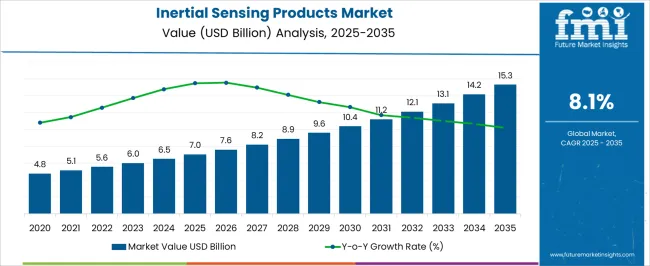
| Metric | Value |
|---|---|
| Inertial Sensing Products Market Estimated Value in (2025 E) | USD 7.0 billion |
| Inertial Sensing Products Market Forecast Value in (2035 F) | USD 15.3 billion |
| Forecast CAGR (2025 to 2035) | 8.1% |
The Inertial Sensing Products market is witnessing robust growth, driven by increasing demand for precise motion tracking and navigation solutions across multiple industries. The adoption of accelerometers, gyroscopes, and other inertial sensing devices is being fueled by applications requiring high accuracy in positioning, orientation, and velocity measurements. Growing investments in autonomous vehicles, industrial automation, aerospace systems, and defense platforms are further accelerating market expansion.
Technological advancements in micro-electromechanical systems, MEMS-based sensors, and miniaturized designs have enhanced performance while reducing size and power consumption. Integration with AI and data analytics systems enables real-time monitoring, predictive maintenance, and improved operational efficiency. Increasing emphasis on smart infrastructure, robotics, and advanced navigation systems is driving demand for reliable and scalable inertial sensing products.
The market is also supported by rising government and private sector funding in defense, transportation, and industrial applications As industries continue to prioritize precision, reliability, and efficiency, the Inertial Sensing Products market is expected to maintain sustained growth in the coming decade.
The inertial sensing products market is segmented by product type, motion, end use, and geographic regions. By product type, inertial sensing products market is divided into Accelerometers and Gyroscopes. In terms of motion, inertial sensing products market is classified into 3D Plane (X-Y-Z Axis), 1D Plane (X Axis), and 2D Plane (X-Y Axis). Based on end use, inertial sensing products market is segmented into Defense (Marine And Naval), Aerospace, Mining, Automotive, Industrial Automation, and Others. Regionally, the inertial sensing products industry is classified into North America, Latin America, Western Europe, Eastern Europe, Balkan & Baltic Countries, Russia & Belarus, Central Asia, East Asia, South Asia & Pacific, and the Middle East & Africa.
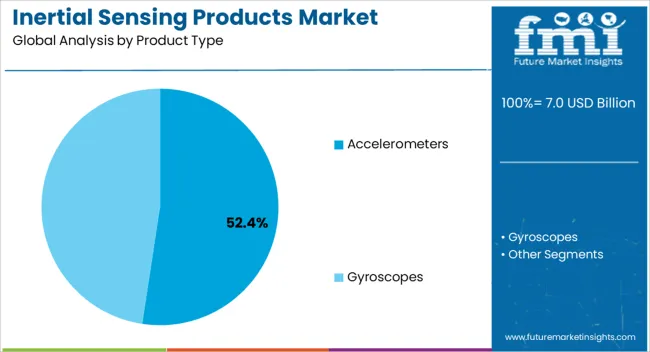
The accelerometers product type segment is projected to hold 52.4% of the market revenue in 2025, establishing it as the leading product category. Growth in this segment is driven by the widespread use of accelerometers for measuring acceleration, vibration, and orientation in various applications, including automotive, aerospace, industrial, and defense systems. MEMS-based accelerometers provide high precision, low power consumption, and compact form factors, making them ideal for integration into portable and embedded devices.
Their capability to capture dynamic motion data in real time supports navigation, motion tracking, and predictive maintenance, enhancing operational efficiency. The flexibility to operate across multiple axes and environments, along with reliability under harsh conditions, has strengthened adoption across industries.
Increasing research and development in sensor performance, sensitivity, and miniaturization is further accelerating growth As applications requiring accurate motion detection and monitoring continue to expand, accelerometers are expected to maintain their leadership position, supported by innovation and growing industry demand.
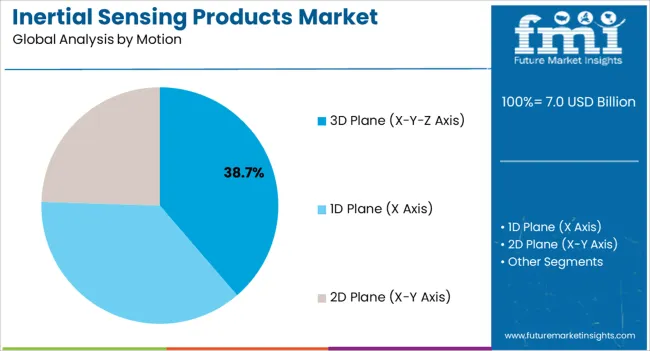
The 3D plane (X-Y-Z axis) motion segment is anticipated to account for 38.7% of the market revenue in 2025, making it the leading motion category. Growth in this segment is being driven by the requirement for multi-axis sensing in applications that demand precise orientation, navigation, and spatial positioning. Sensors capable of capturing motion across three axes provide comprehensive data for autonomous vehicles, robotics, aerospace systems, and industrial machinery.
Integration with inertial measurement units and AI analytics enhances real-time monitoring and predictive capabilities. The ability to accurately track complex motion patterns in three-dimensional space improves system reliability and operational performance.
Rising adoption of autonomous platforms, UAVs, and smart industrial solutions further supports this segment As industries prioritize precision, safety, and real-time motion analytics, the 3D plane motion category is expected to remain the primary driver of market growth, reinforced by ongoing innovation in multi-axis sensing technologies.
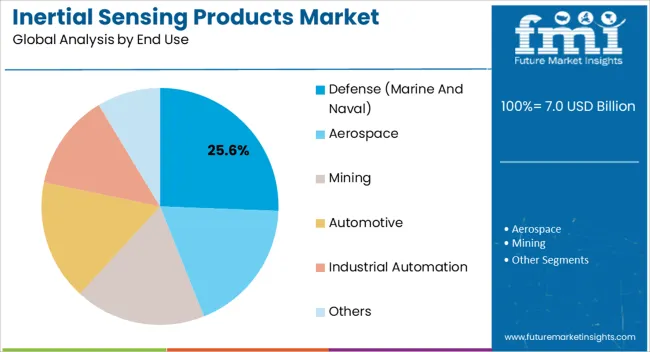
The defense (marine and naval) segment is projected to hold 25.6% of the market revenue in 2025, positioning it as the leading end-use industry. Growth in this segment is being driven by the increasing need for advanced navigation, guidance, and stabilization systems in naval and marine platforms. Inertial sensing products provide accurate motion detection and orientation information in challenging environments, ensuring reliable performance under extreme conditions such as turbulent seas and complex operational scenarios.
Integration with autonomous naval vessels, submarines, and defense navigation systems enhances situational awareness, operational efficiency, and mission effectiveness. Government investments in maritime defense modernization, naval fleet expansion, and strategic surveillance programs are further supporting adoption.
The ability to deploy sensors in harsh and dynamic environments without compromising accuracy strengthens the segment’s market position As naval operations become more technologically sophisticated and reliant on precise navigation and stabilization systems, the defense (marine and naval) segment is expected to maintain its leadership, driven by innovation and strategic deployment of inertial sensing products.
Inertial sensors are a class of specialized sensors, which operate on the principle of inertia, where a small displacement caused by peripheral vibrations and oscillations result in generation of electronic output signal by the sensor material. The Inertial Sensing products market has evolved with advent of semiconductor electronics industry with manufacturers providing state-of-the-art as well as efficient devices in the field of sensor devices.
The sensors are integrated into an electronic component with appropriate calibration done on sensor material to produce desired output signal. Inertial sensing products mainly find their applications where displacement, positioning and motion tracking of objects and equipment are required.
The sensing range ranges from a few square millimetre upto 500 millimetre in diameter. The portability, degree of accuracy associated with inertial sensing products make it a preferred choice by the end users for measuring and navigation applications.
Inertial sensors are used to detect and measure acceleration, vibration, tilt, shock and multiple Degrees-of-Freedom (DoF) motion. The devices equipped with inertial sensing products such as accelerometers, gyroscopes, etc. are offered separately or as integrated inertia measurement units.
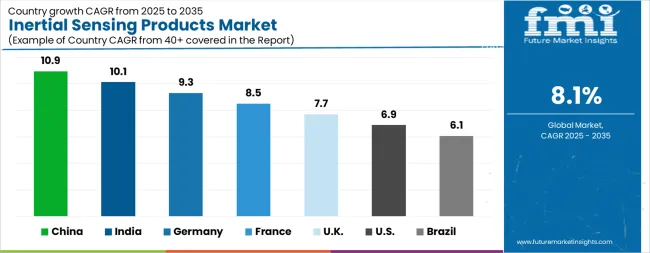
| Country | CAGR |
|---|---|
| China | 10.9% |
| India | 10.1% |
| Germany | 9.3% |
| France | 8.5% |
| UK | 7.7% |
| USA | 6.9% |
| Brazil | 6.1% |
The Inertial Sensing Products Market is expected to register a CAGR of 8.1% during the forecast period, exhibiting varied country level momentum. China leads with the highest CAGR of 10.9%, followed by India at 10.1%. Developed markets such as Germany, France, and the UK continue to expand steadily, while the USA is likely to grow at consistent rates. Brazil posts the lowest CAGR at 6.1%, yet still underscores a broadly positive trajectory for the global Inertial Sensing Products Market. In 2024, Germany held a dominant revenue in the Western Europe market and is expected to grow with a CAGR of 9.3%. The USA Inertial Sensing Products Market is estimated to be valued at USD 2.6 billion in 2025 and is anticipated to reach a valuation of USD 5.0 billion by 2035. Sales are projected to rise at a CAGR of 6.9% over the forecast period between 2025 and 2035. While Japan and South Korea markets are estimated to be valued at USD 316.8 million and USD 178.8 million respectively in 2025.
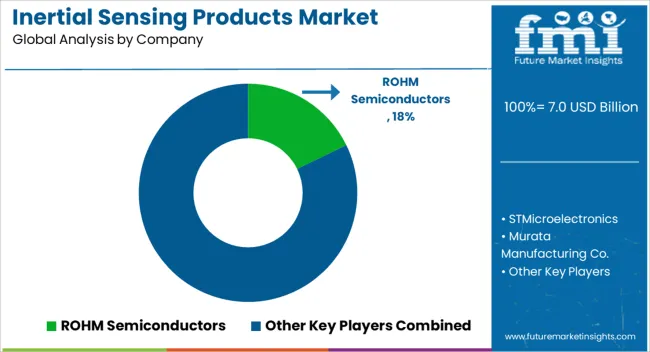
| Item | Value |
|---|---|
| Quantitative Units | USD 7.0 Billion |
| Product Type | Accelerometers and Gyroscopes |
| Motion | 3D Plane (X-Y-Z Axis), 1D Plane (X Axis), and 2D Plane (X-Y Axis) |
| End Use | Defense (Marine And Naval), Aerospace, Mining, Automotive, Industrial Automation, and Others |
| Regions Covered | North America, Europe, Asia-Pacific, Latin America, Middle East & Africa |
| Country Covered | United States, Canada, Germany, France, United Kingdom, China, Japan, India, Brazil, South Africa |
| Key Companies Profiled | ROHM Semiconductors, STMicroelectronics, Murata Manufacturing Co., InvenSense Inc, Maxim Integrated, First Sensors AG, LORD Microstrain, TE Connectivity, and Xsens |
The global inertial sensing products market is estimated to be valued at USD 7.0 billion in 2025.
The market size for the inertial sensing products market is projected to reach USD 15.3 billion by 2035.
The inertial sensing products market is expected to grow at a 8.1% CAGR between 2025 and 2035.
The key product types in inertial sensing products market are accelerometers and gyroscopes.
In terms of motion, 3D plane (x-y-z axis) segment to command 38.7% share in the inertial sensing products market in 2025.






Our Research Products

The "Full Research Suite" delivers actionable market intel, deep dives on markets or technologies, so clients act faster, cut risk, and unlock growth.

The Leaderboard benchmarks and ranks top vendors, classifying them as Established Leaders, Leading Challengers, or Disruptors & Challengers.

Locates where complements amplify value and substitutes erode it, forecasting net impact by horizon

We deliver granular, decision-grade intel: market sizing, 5-year forecasts, pricing, adoption, usage, revenue, and operational KPIs—plus competitor tracking, regulation, and value chains—across 60 countries broadly.

Spot the shifts before they hit your P&L. We track inflection points, adoption curves, pricing moves, and ecosystem plays to show where demand is heading, why it is changing, and what to do next across high-growth markets and disruptive tech

Real-time reads of user behavior. We track shifting priorities, perceptions of today’s and next-gen services, and provider experience, then pace how fast tech moves from trial to adoption, blending buyer, consumer, and channel inputs with social signals (#WhySwitch, #UX).

Partner with our analyst team to build a custom report designed around your business priorities. From analysing market trends to assessing competitors or crafting bespoke datasets, we tailor insights to your needs.
Supplier Intelligence
Discovery & Profiling
Capacity & Footprint
Performance & Risk
Compliance & Governance
Commercial Readiness
Who Supplies Whom
Scorecards & Shortlists
Playbooks & Docs
Category Intelligence
Definition & Scope
Demand & Use Cases
Cost Drivers
Market Structure
Supply Chain Map
Trade & Policy
Operating Norms
Deliverables
Buyer Intelligence
Account Basics
Spend & Scope
Procurement Model
Vendor Requirements
Terms & Policies
Entry Strategy
Pain Points & Triggers
Outputs
Pricing Analysis
Benchmarks
Trends
Should-Cost
Indexation
Landed Cost
Commercial Terms
Deliverables
Brand Analysis
Positioning & Value Prop
Share & Presence
Customer Evidence
Go-to-Market
Digital & Reputation
Compliance & Trust
KPIs & Gaps
Outputs
Full Research Suite comprises of:
Market outlook & trends analysis
Interviews & case studies
Strategic recommendations
Vendor profiles & capabilities analysis
5-year forecasts
8 regions and 60+ country-level data splits
Market segment data splits
12 months of continuous data updates
DELIVERED AS:
PDF EXCEL ONLINE
Products from Food Waste Industry Analysis in Korea Size, Share and Forecast Outlook 2025 to 2035
Products from Food Waste in Japan - Size, Share, and Forecast Outlook 2025 to 2035
Products from Food Waste Market Analysis - Size, Growth, and Forecast 2025 to 2035
Inertial Navigation System Market
Sensing Cable Market
USA Products from Food Waste Market Growth – Trends, Demand & Outlook 2025-2035
Self Sensing Nanocomposites Market Size and Share Forecast Outlook 2025 to 2035
Teff Products Market
Detox Products Market Analysis - Size, Share, and Forecast Outlook 2025 to 2035
Algae Products Market Analysis - Size, Share, and Forecast Outlook 2025 to 2035
Pulse Products Market Analysis - Size, Share, and Forecast Outlook 2025 to 2035
Dairy Products Market Analysis by Product Type, End Use, Distribution Channel and Region through 2035
Depth Sensing Market Trends - Growth & Forecast 2025 to 2035
Vacuum Products for Emergency Services Market Size and Share Forecast Outlook 2025 to 2035
Almond Products Market Size and Share Forecast Outlook 2025 to 2035
Remote Sensing Services Market Trends - Growth & Forecast 2025 to 2035
Bamboo Products Market Analysis – Trends & Growth 2025 to 2035
Luxury Products For Kids Market - Trends, Growth & Forecast 2025 to 2035
Chicory Products Market Size and Share Forecast Outlook 2025 to 2035
Crystal Products Market Size and Share Forecast Outlook 2025 to 2035

Thank you!
You will receive an email from our Business Development Manager. Please be sure to check your SPAM/JUNK folder too.
Chat With
MaRIA